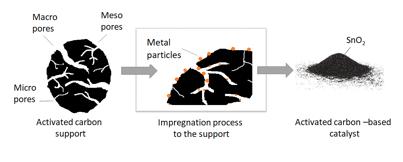1.3.2 RESULTS Biomass characterizations The fiber sludge used in the studies consisted mainly of cellulose (98%, dry weight). In addition, it contained small amounts of hemicellulose (1%) and ash (1%). Fiber sludge and spruce hydrolysates were water solutions, which contained sugars (mainly glucose) 11.9% and 9.2%, respectively.
Glucose conversion to lactic acid with heterogeneous activated carbon-supported metal oxide catalysts The catalysts (Figure 12) used to convert glucose to lactic acid were prepared from hydrolysis lignin in work package 2, where more information about catalyst preparation and characterization can be read. The glucose conversion reactions were performed in various conditions to find the best catalyst, and to optimize the reaction time, temperature, pressure, and catalyst amount. Selected results are given in Table 1. Based on the results the highest lactic acid yield achieved was 42%, which was produced with Sn/ Al5/2.5@AC catalyst (prepared from steam activated and nitric acid modified activated carbon) at 180 oC in 20 min with the pressure of 5 bars. In order to study the recyclability of the used catalyst, it was recovered from the reaction solution, washed and used again four times. The yield of lactic acid varied from 15 to 20% during the recycling experiments. The decrease in the lactic acid yield indicated that the catalyst was not stable in the aqueous reaction solution, which was probably caused by the deposition of carbonaceous byproducts, such as humines, on the catalyst’s active sites, as well as by the leaching of aluminum oxides as active metal. More detailed information about the glucose conversion to lactic acid can be read from the Kupila et al., 2021a.
Catalyst1 Catalyst support2 - - AC3 ACZN Sn10@AC ACZN Sn/Al5/5@AC ACZN Sn/Al5/2.5@AC ACZN Sn/Al5/2.5@AC ACS ACSN ACZN Sn/Al5/2.5@AC ACSN
Reaction conditions Lactic acid yield (%) 180 oC, 120 min, 30 bar 5 180 oC, 120 min, 30 bar, 0.1 g of catalyst 5 o 180 C, 120 min, 30 bar, 0.1 g of catalyst 19 180 oC, 120 min, 30 bar, 0.1 g of catalyst 27 180 oC, 120 min, 30 bar, 0.1 g of catalyst 31 24 180 oC, 120 min, 30 bar, 0.1 g of catalyst 34 31 180 oC, 20 min, 5 bar, 0.2 g catalyst 42
Table 1. Glucose (0.1 g) conversion to lactic acid in water (20 ml) and N2 atmosphere with various catalysts 1 Sn10, Sn/Al5/5 or Sn/Al5/2.5 means that catalyst contains 10, 5 or 2.5 wt-% of the active metal(s) 2 ZN means chemically activated, nitric acid modified AC, S steam activated AC, and SN steam activated, nitric acid modified AC 3 AC means activated carbon
Glucose/hydrolysate conversion to ethyl lactate with heterogeneous activated carbonsupported metal oxide catalysts Glucose, fiber sludge hydrolysate, and spruce hydrolysate were used as raw materials in ethyl lactate production (Figure 12). The catalysts used in the reactions were prepared from hydrolysis lignin in work package 2, where more information can again be read. The reactions were performed in various conditions to find the best catalyst, and to optimize the reaction conditions. With glucose as the feedstock the highest ethyl lactate yield was achieved with a zinc containing catalyst. The recycling experiments showed that the catalyst began to deactivate in use; however, reactivation of the catalyst increased the ethyl lactate yield to the same level as it was after the first cycle. GREEN BIORAFF SOLUTIONS
13








